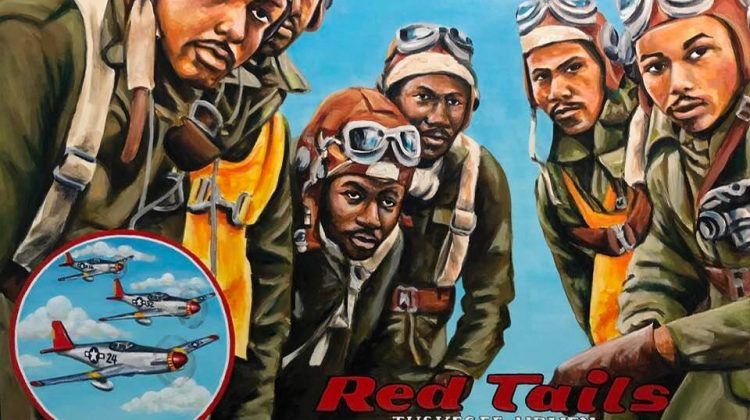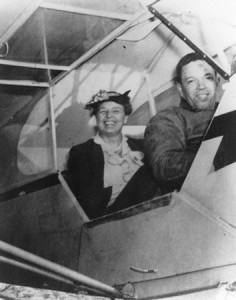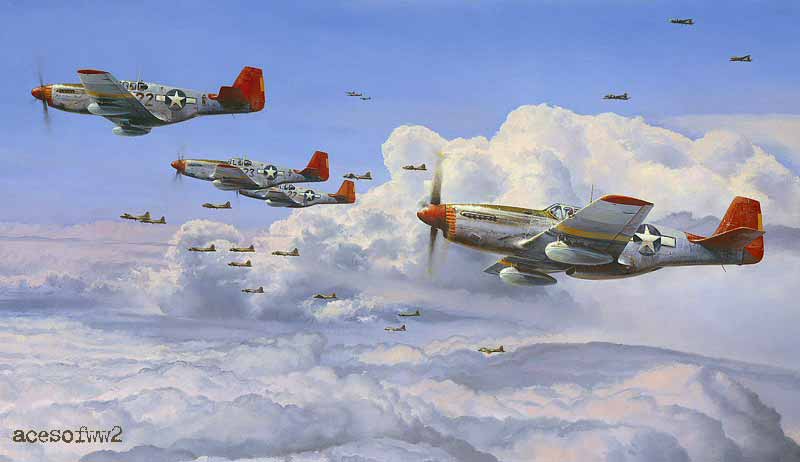

Good Morning POU!
In an era when African-Americans were treated like sub-humans, a group of African-Americans were flying the most advanced technology the U.S. military had to offer. These WWII-era pilots, along with support crew, are known as the Tuskegee Airmen. Although there were a number of Tuskegee units in the Army Air Corps, the units who flew red-tailed P-51 Mustangs are the best known.
The story of the “Red Tails” began at Tuskegee Army Airfield, a base built exclusively for training African-American military pilots. Located in the heartland of racism, views contained in “The Use of Negro Manpower in War,” an official U.S. Army report, were still widely accepted. Published in 1925, the report concluded that black men were “very low in the scale of human evolution.” The first class of thirteen men set out to make history and to change the status quo. Five airmen earned their wings in March 1942. They became the 99th Pursuit (later Fighter) Squadron.
 “
“
Chief” Anderson and First Lady Eleanor Roosevelt March, 1941. Image credit: Air Force Historical Research Agency. Caption credit: National Park Service.
Efforts to educate the American public—and remove doubts regarding the airmen’s abilities—took root and continued throughout the war effort. First Lady Eleanor Roosevelt flew with an African-American pilot at Tuskegee; War Bond posters featuring the airmen were circulated; and Ronald Reagan narrated a pro-Tuskegee film titled Wings for this Man (1945), saying about an already very accomplished Tuskegee unit:
“One thing was proved here: that you can’t judge a man by the color of his eyes or the shape of his nose.”
The 99th deployed to North Africa in 1943 and, while flying P-40s, was tasked with missions that kept them from engaging in air-air combat—a sign higher-ups doubted their abilities. They were later joined by the 100th, the 301st, and the 302nd. The four squadrons comprised the 332nd Fighter Group.
When the 332nd was reassigned, it was tasked with escorting the heavy bombers of the Fifteenth Air Force into enemy territory. The airmen were entrenched in the business of aerial combat. They received P-51s a month later and, in July 1944, their famous red-tailed planes took to the air.


Although they received the missions they’d wanted, racism still plagued the unit. They had more to prove than the average pilots.
Up against them: Out of all the units that flew P-51s in the Fifteenth Air Force, the 332nd scored the lowest number of aerial victories—and it didn’t have a single Ace pilot, either. These stats were used against the Tuskegee Airmen, used to buttress claims that they were unskilled pilots because of their skin color.
However, the claims fall flat against this stat: Average number of bombers lost during escorts? Forty-six. The Tuskegee Airmen lost 27.
The airmen had been told to protect bombers. Rather than breaking away to engage enemy pilots, they stayed close to the bombers they were escorting. It was a tactic that worked. They lost the personal glory that came with dog fighting, but they kept Americans alive. Mission accomplished.

The 332nd’s toughest mission occurred March 24, 1945. Tasked with escorting bombers deep into enemy territory, the Tuskegee Airmen, along with four other escort groups, flew a 1,600-mile roundtrip mission to Berlin. Led by Benjamin O. Davis Jr., the son of the first African-American general ever in the U.S. Military, and a member of the very first Tuskegee class, the 332nd helped to bring every bomber back safe. The mission to Berlin and back earned the 332nd a Distinguished Unit Citation. Years later, Davis, Jr. became U.S. Air Force’s first African-American general officer and eventually achieved the rank of Lt. General (three stars).
Training African-Americans to fly for the U.S. military began as an experiment. The men who took the challenge and willingly served a country that marginalized their existence were trailblazers—in the truest sense.
